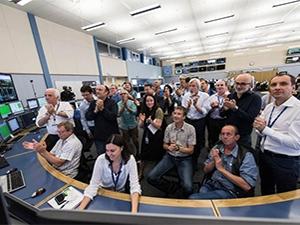
The second stage of a multinational project aimed at unravelling the mysteries of the universe kicked off yesterday as the Large Hadron Collider (LHC) started delivering data again.
The LHC had been shut down for 27 months as it went through a re-commissioning phase post its delivery of the data that proved a particle discovered in July 2012 is a type of Higgs boson, a finding that could be the most substantial physics discovery of our time.
The Higgs particle is the missing piece of the Standard Model of Physics, a set of rules that outline the fundamental building blocks of the universe, such as protons, electrons and atoms. Finding it starts a new era for science, because scientists will be able to probe parts of the universe that have not previously been investigated.
Yesterday, the European Organisation for Nuclear Research (CERN) noted the LHC started delivering physics data for the first time in 27 months. "After an almost two-year shutdown and several months re-commissioning, the LHC is now providing collisions to all of its experiments at the unprecedented energy of 13 TeV, almost double the collision energy of its first run."
Next-generation science
The second phase of the LHC will run around the clock for the next three years, "opening the way to new discoveries", says CERN. The LHC is a £2.6 billion "Big Bang" particle accelerator at the centre of the hunt for the Higgs boson. It has been dubbed the world's largest experiment and is housed at CERN.
The LHC is the largest scientific instrument ever built. It lies in an underground tunnel with a circumference of 27km that straddles the French-Swiss border, near Geneva, and has been heralded as the most important new physics discovery machine of all time.
"With the LHC back in the collision-production mode, we celebrate the end of two months of beam commissioning," said CERN director of accelerators and technology Fr'ed'erick Bordry. "It is a great accomplishment and a rewarding moment for all of the teams involved in the work performed during the long shutdown of the LHC, in the powering tests and in the beam commissioning process. All these people have dedicated so much of their time to making this happen."
Locally, about 70 South Africans are involved in the global project and, while the team is small in comparison to those from other countries, the universities involved are reaping research benefits. Four universities are participating in the programme: Wits, University of Cape Town, the University of Johannesburg, and the University of KwaZulu-Natal.
Yesterday morning, LHC operators declared the beams were stable, which is the signal for the LHC experiments to start taking data. CERN explains beams are made of trains of proton bunches moving at almost the speed of light around the 27km ring of the LHC.
These so-called bunch trains circulate in opposite directions, guided by powerful superconducting magnets, it notes. Yesterday, the LHC was filled with six bunches each containing around 100 billion protons. This rate will be progressively increased as the run goes on to 2 808 bunches per beam, allowing the LHC to produce up to a billion collisions per second.
Share